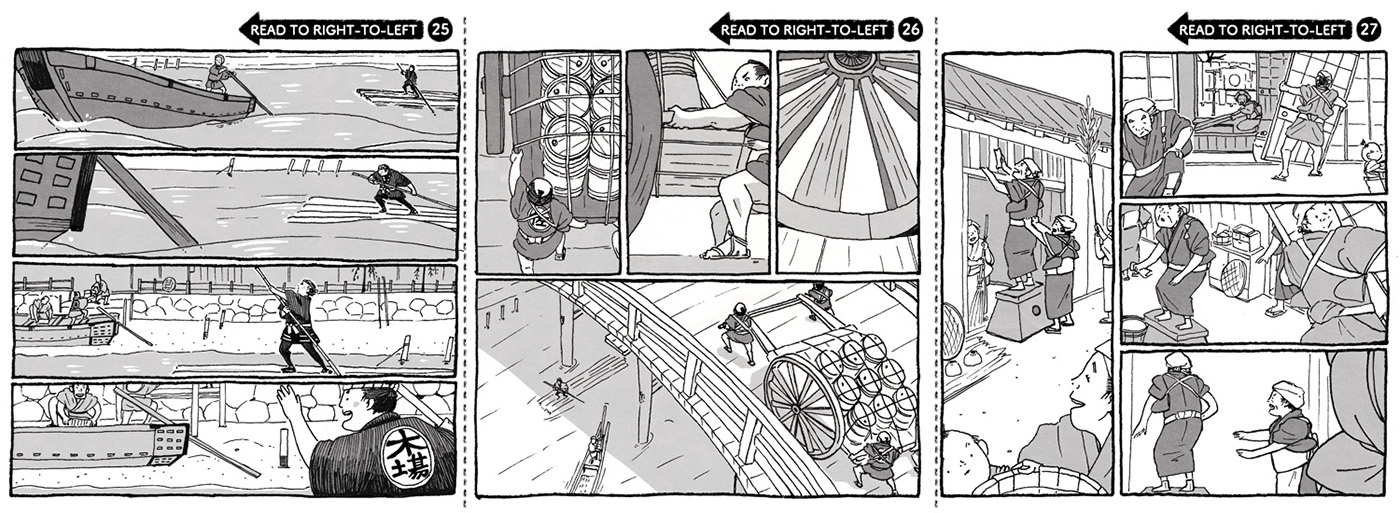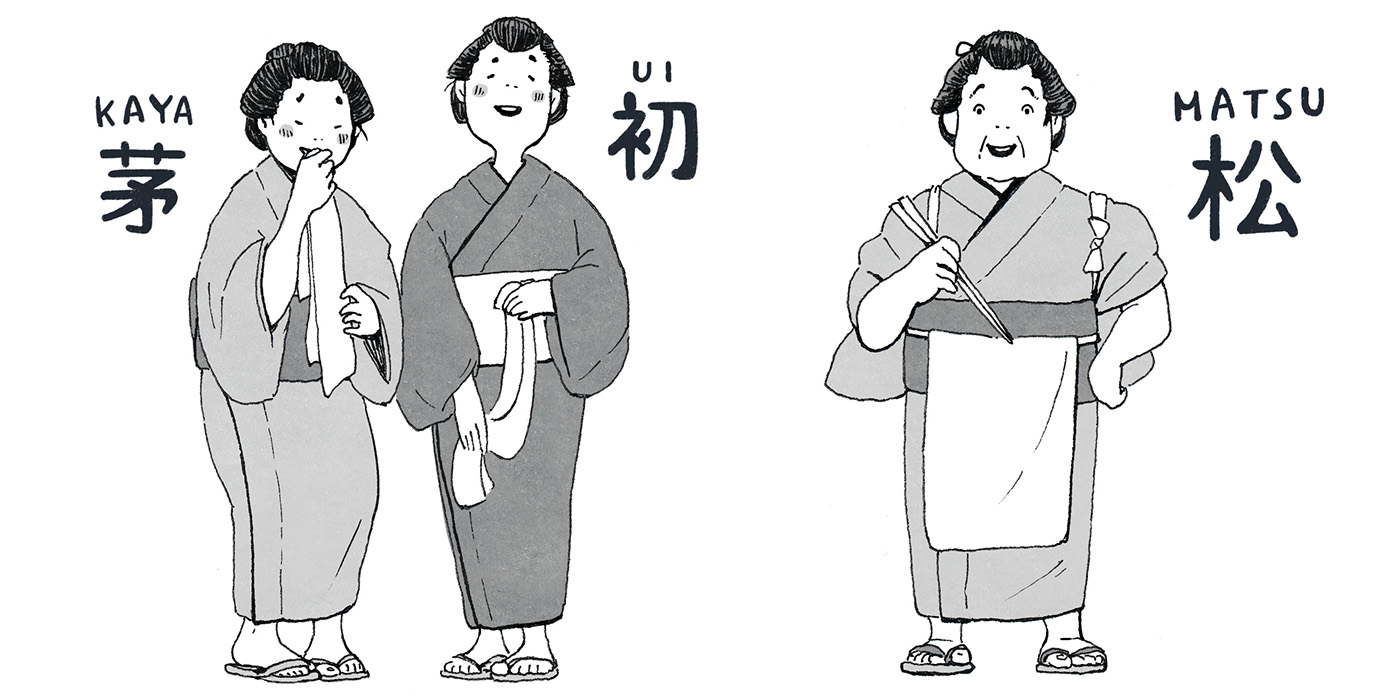
今年のInktoberでは、毎日一枚ずつ漫画を描きました!以前から興味のあった江戸時代の長屋の人たちをメインに、Inktoberのオフィシャルテーマに沿って話を作っています。
旧暦の10月は、今の暦で11中旬から12月中旬にあたるため、10月から年末の季節が舞台です。
For this year's Inktober I drew a short comic every day! Since I have been curious about the Edo (old Tokyo) period and the "Nagaya" long-houses for some time I decided to combine this topic with the official Inktober daily keywords.
Also because of the different calendar used in the Edo period - (October now is about the end of the year then) I decided to picture such time in this project.
Also because of the different calendar used in the Edo period - (October now is about the end of the year then) I decided to picture such time in this project.

1:SWIFT(早い) 十墨長屋を風のように横切る飛脚です。長屋の入り口は木戸になっていて、早朝に開けて日が落ちると閉めることで防犯の役割をしています。
1: SWIFT a postman running past the "Nagaya" as swift as the wind. The wooden doors (or gate) to the whole long-house were opened early in the morning and closed at dusk for crime prevention.
2:DIVIDED(分割) 豆腐は江戸時代中期には庶民も手軽に食べられる食材になり、獣肉食を避けていた当時では大事なタンパク質そうな。あと豆腐を切る音を閃いた時は嬉しかったです!:)
2: DIVIDED Tofu became cheap enough for everyone to enjoy around the middle of Edo period. Until then it was quite expensive! Tofu was a precious source of protein, because eating meat was really rare.
3:POISON(毒) 当時から伝わる「石見銀山ネズミ捕り」またの名を「猫いらず」の売り子さんです。長屋暮らしではお米をネズミから守るのは必須!
3: POISON This episode features a mice poison seller. This poison popularly called "no need for cat" was sold up until Meiji period. It was a necessity to protect the precious rice.
~ ~ ~ ~ ~ ~ ~ ~ ~ ~ ~ ~ ~ ~ ~ ~ ~ ~ ~ ~ ~ ~ ~ ~ ~ ~ ~ ~

4:UNDERWATER(水中) イワシの棒手振りとイワシ雲。祖母曰く「イワーシ コイッ」の「コイッ」を短く言うそうです。この一枚は筆とインクで描いてみました。
4: UNDERWATER A fish (iwashi fish) peddled looking at a sky filled with autumn clouds also called "iwashi" because they look like a group of fish swimming together. I painted this one with ink and a brush (Windsor and Newton series 7).
5:LONG(長い) 秋の夜長にお月見をする姉妹です。収穫祝の行事でもあるお月見では里芋などを食べる風習もあります。この一枚はつけペンと薄墨筆ペンで描きました。
5: LONG Two sisters watching the moon on a long autumn evening. "Moon watching" was a part of celebrating good harvest. Eating sweet potatoes was part of the custom.
I drew this one using a manga inking nib pen and diluted ink.
I drew this one using a manga inking nib pen and diluted ink.
6:SWORD(剣) 浪人も、刀は春と秋の二回は分解して手入れをしたそうです。手入れの仕方は映画「たそがれ清兵衛」で勉強しました!
6: SWORD A good swordsman would clean his weapon at lest 2 times a year after disassembling it. I drew this scene based on a Japanese movie "The Twilight Samurai".
~ ~ ~ ~ ~ ~ ~ ~ ~ ~ ~ ~ ~ ~ ~ ~ ~ ~ ~ ~ ~ ~ ~ ~ ~ ~ ~ ~

7:SHY(恥ずかしがり屋) こっそり柿を差し入れるこの坊主はシリーズを通してちょいちょい登場しています。:) 柿の色はぺんてるの筆ペンの朱墨をつかってます。
7: SHY The child shyly leaving the kaki fruit is featured a lot in this series.
For the red-orange Kaki fruit I used the red ink brush-pen made by pentel.
For the red-orange Kaki fruit I used the red ink brush-pen made by pentel.
8:CROOKED(曲がった) 職人や火消しの間では、髷を曲げるのが粋だったそうです。
8: CROOKED All the “cool” guys at the time preferred a little angle to their hairdo :)
9:SCREECH(甲高い叫び) 先日カラスが思いの外近くで鳴いてびっくりしました⋯。秋には綿入れを仕立てて冬支度をします。
9: SCREECH As it was becoming colder in old Tokyo (Edo) it was usual to put cotton lining inside kimonos. You can see how it looks like in this video: https://www.youtube.com/watch?v=nOORp04VflU
~ ~ ~ ~ ~ ~ ~ ~ ~ ~ ~ ~ ~ ~ ~ ~ ~ ~ ~ ~ ~ ~ ~ ~ ~ ~ ~ ~

10:GIGANTIC(巨大) 巨大と言ったら力士!この頃は帯刀を許されていたけど、素手でも十分強そう。この一枚は呉竹の筆ペンを使ってみました。
10: GIGANTIC If it comes to size a sumo wrestler is definitely gigantic! At that time they were allowed to carry katana swords but even without one they were formidable enough!
For this comic I used a brush-pen made by Kuretake.
For this comic I used a brush-pen made by Kuretake.
11:RUN(走る) 江戸時代の267年間で986回も火事が起こった江戸では、火消しは花形職業です!
11: RUN As the city was mostly wooden the firefighters where really important! During 267 years of Edo there were 986 fires!
12:SHATTERED(粉々になった) スローモーションで割れる器の悲しげだ…。割れたお茶碗は焼継ぎ師に頼んで直してもらったそうだけど、ここまで粉々でもお願いできるのかな?
12: SHATTERED A bowl breaking in slow-motion is a pitiful sight indeed! The broken remains were often repaired again.
~ ~ ~ ~ ~ ~ ~ ~ ~ ~ ~ ~ ~ ~ ~ ~ ~ ~ ~ ~ ~ ~ ~ ~ ~ ~ ~ ~

13:”TEEMING(ごった返す)” 晩秋のお祭り「酉の市」です。福をかっこむ熊手は今ほどゴージャスではなかったそうな。この一枚からRAPIDOGRAPHを使い始めました。
13: TEEMING A scene of buying an item that is supposed to bring luck at a crowded temple.
From this episode I started using KOH-I-NOOR Rapidograph pens for this project.
From this episode I started using KOH-I-NOOR Rapidograph pens for this project.
14:"FIERCE(激しい)” おでん屋VS蕎麦屋です。おでんをおかずに蕎麦をすすれば解決!
14: FIERCE A fierce competition between soba and oden stall owners. (Both delicious Japanese foods) In the end you would have to eat both to get out of this alive.
15:”MYSTERIOUS(ミステリアス)” 長屋の小さいお稲荷さんと友達な、猫又です。
15: MYSTERIOUS In Edo Tokyo, if a cat is really old it becomes a Youkai (a spirit) with two tails - a Nekomata.
~ ~ ~ ~ ~ ~ ~ ~ ~ ~ ~ ~ ~ ~ ~ ~ ~ ~ ~ ~ ~ ~ ~ ~ ~ ~ ~ ~

16:FAT(太った) 当時流行した大食い大会です。他にも酒部門や甘いもの部門もあって、身分関係なく我こそはという大食らいが集まったとか!
16: FAT In Edo (old Tokyo) “who can eat/drink the most” competitions were really popular and the records of such events and famous feats remain till this day!
17:GRACEFUL(優美な) 武士の家系で、所作の美しい姉弟です。
17: GRECEFUL In Edo the house manners differed from house to house but both the host and the visitor here moved like in a dance.
18:FILTHY(汚い) 水や薪が貴重だった江戸では浴室を持つ家は稀で、ほとんどの江戸市民は大衆浴場へ通ってました。浴槽は屋根のついた奥まったとこにあって、湯の温度が下がらないように篭った作りになってます。
18: FILTHY Because water and firewood were really precious in Edo (old Tokyo) houses having their own baths were a rarity. Most of the citizens used public bats called "sentō". The bath with hot water was in the back, behind a low wall to keep the water from cooling down.
~ ~ ~ ~ ~ ~ ~ ~ ~ ~ ~ ~ ~ ~ ~ ~ ~ ~ ~ ~ ~ ~ ~ ~ ~ ~ ~ ~

19:CLOUD(雲) 雲より高い家を夢見る鳶職人たちです。歌ってるのは「木遣り」という労働歌で、今はお祭とか結婚式とかで歌われています。
19: CLOUD Construction crew building higher than clouds singing a special “work chant”!
20:DEEP(深い) 長屋の社交場、井戸端で見つけた秋です。実はこの二人はお月見をしていた姉妹だったり。:)
20: DEEP A well located between buildings was a busy part of life in Edo. They are the same sisters that were looking at the moon.
21:FURIOUS(怒り狂う) 火消しのめ組と関取が起こした有名な騒動「め組の喧嘩」。その後お芝居で人気になって、現代も歌舞伎の演目で有名です!
21: FURIOUS A big, famous fight between the “ME” firefighters brigade and sumo wrestlers! It’s a historical fact!
~ ~ ~ ~ ~ ~ ~ ~ ~ ~ ~ ~ ~ ~ ~ ~ ~ ~ ~ ~ ~ ~ ~ ~ ~ ~ ~ ~

22:TRAIL(通った後) 江戸時代の頃は小氷河期で今より寒かったらしく、浮世絵では江戸でも雪がドカ降りした様子がよく描かれてます:)
22: TRAIL According to historical data it seems that Edo (old Tokyo) was a lot cooler than it is currently! On old paintings and prints there is a lot of snow - something very rare in Tokyo today.
23:JUICY(ジューシー) 当時は小腹が空いた時に手軽に食べるものだったお稲荷さん。当時の形には諸説あるようですが、大ぶりだったっぽい。
23: JUICY This time a juicy Inari Sushi - rice in a fried tofu pocket. Delicious!
24:BLIND(見えない) 本に夢中な女性です。たまにどうやっても手があたらない時ありませんか?
24: BLIND Looking blindly for tea while deep into a new book.
~ ~ ~ ~ ~ ~ ~ ~ ~ ~ ~ ~ ~ ~ ~ ~ ~ ~ ~ ~ ~ ~ ~ ~ ~ ~ ~ ~

25:SHIP(船) 木材を筏にして運んだ筏師は、川が物流のメインだった当時ならではです!粋な風景ですなあ:)
25: SHIP The river was full of small ships and raftsmen transporting goods and raw materials!
26:SQUEAK(軋む) 陸路では大八車が活躍しました。実物を見たことないけど、水車小屋の歯車みたいな音がしたかなと想像してます!
26:SQUEAK(軋む) 陸路では大八車が活躍しました。実物を見たことないけど、水車小屋の歯車みたいな音がしたかなと想像してます!
26: SQUEAK A cart passing over the river was a usual sight in old Tokyo. Big-wheeled carts like this called "dai-hachi-guruma" were really popular for transporting goods - there were almost no horses or oxen in the city. The carts made noises similar to what a water wheel sounds - I think!
27:CLIMB(登る) すす払いで高いところを掃除したがる長屋の差配さんと、心配する面々です。おじいちゃんて、ちょっと危ないとことか掃除したがるのはなんででしょ:D
27:CLIMB(登る) すす払いで高いところを掃除したがる長屋の差配さんと、心配する面々です。おじいちゃんて、ちょっと危ないとことか掃除したがるのはなんででしょ:D
27: CLIMB Everyone participating in the new year’s cleaning! The landlord trying to reach a particularly high spot and tenants worried about him.
~ ~ ~ ~ ~ ~ ~ ~ ~ ~ ~ ~ ~ ~ ~ ~ ~ ~ ~ ~ ~ ~ ~ ~ ~ ~ ~ ~

28:FALL(落ちる) そしてすす払いの後は胴上げしたそうです、楽しげでいいですな!
28: FALL After the cleaning was finished everybody celebrated like this
29:UNITED(連合) 「引きずり餅」という年末の餅をついてくれる餅つき集団がいて、お米屋さんとか鳶職が集まったとか。
29: UNITED For New Year’s celebrations “mochi” rice dumplings are needed. People usually doing other work also take part in pounding rice for the dumplings!
30:FOUND(見つけた) 歳の市で、迷子になった子供をみつけるお母さんです。よく迷子になってた頃を思い出しました。:)
30: FOUND A kid was lost and found during the New Year’s celebrations rush to buy well being charms for the next year.
~ ~ ~ ~ ~ ~ ~ ~ ~ ~ ~ ~ ~ ~ ~ ~ ~ ~ ~ ~ ~ ~ ~ ~ ~ ~ ~ ~

31:MASK(仮面) 最後はおめでたく、お神楽でしめです!
31: MASK A mask dance - part of the end of the year celebrations!
31: MASK A mask dance - part of the end of the year celebrations!
~ ~ ~ ~ ~ ~ ~ ~ ~ ~ ~ ~ ~ ~ ~ ~ ~ ~ ~ ~ ~ ~ ~ ~ ~ ~ ~ ~
そして毎日描くうちにだんだんと登場人物ができていったので、キャラクターとしてまとめました。みんな舞台になった十墨長屋の住人です。
While I was drawing the series the image of the characters living in the long-house and appearing in many episodes gradually solidified! I made a little summary for the main ones:
While I was drawing the series the image of the characters living in the long-house and appearing in many episodes gradually solidified! I made a little summary for the main ones:

左:茅(かや) 右:初(うい) 年子の姉妹、左が妹の茅(かや)で右が姉の初(うい)です。姉の初は伊勢屋という味噌問屋で通い奉公をしてます。貸本屋で借りては仕事終わりに読書するのが楽しみ。妹の茅は近所の松屋という蕎麦屋で接客をしてます、手先は不器用だけど愛嬌があり仕事が楽しい。2人住まいで、季節のイベントを楽しむなど仲良く暮らしてます。あと2人とも芋系が好き。
Left: Kaya, right: Ui sisters (year apart). Ui works in a miso shop “Iseya” and likes reading books borrowed from a “Kashi-Hon-Ya” - something that we would call a library now.Younger sister, Kaya works as a waitress in a soba shop “Matsuya”. She is a little clumsy but honest working and is liked by everyone. They live together in one of the small apartments of the nagaya looking forward to season’s festivals. The potato based food.
登場回 / Featured in:Episode 5,20,24
彼女は十墨長屋の表に店を構える煮売屋です。今で言うお惣菜屋さんみたいなもので、独身男性が多かった江戸で重宝されてるそうな。お酒をだす店も多い中、酔っ払いの相手は面倒なのでお茶しかだしてません。おっちょこちょいでよくお皿を割ってしまう。
Mrs Matsu lives in the biggest of the apartments in the “NAGAYA” (long house). Because Edo (old Tokyo) was full of unmarried men (2 times more men than women) shops that were selling ready-cooked food were very popular and Mrs Matsu also runs one. She does not sell alcohol (sake) because she doesn’t want to deal with drunk men. She is little bit clumsy and brakes dishes a lot.
Tomorrow I will introduce you to her husband (it’s him trying to catch the small bowl in the second strip).
登場回 / Featured in:Episode 10,12
~ ~ ~ ~ ~ ~ ~ ~ ~ ~ ~ ~ ~ ~ ~ ~ ~ ~ ~ ~ ~ ~ ~ ~ ~ ~ ~ ~

角造さん お松さんの夫で、担ぎ屋台でおでん屋をしてます。元は鳶職人だったけど怪我で引退し、通っていたおでん屋のおじいさんとお松さんに教わっておでん屋をはじめました。19枚目の漫画は、彼が鳶職人時代に見ていた「富士山よりでかい家を建てる」という夢です。この夢にでている鳶職の人たちは、よく角造さんの店へ食べにきます。:)
Husband of Mrs Matsu - Kakuzou. He is running a small oden (Japanese one pot winter dish) stall, but before that he worked as a construction foreman. He quit due to an injury and learned how to cook from his wife.
登場回 / Featured in:Episode 14,19
末吉さん そのおでん屋の隣に店をだしてるのが、二八蕎麦屋の末吉さんです。料亭で包丁を握っていたけど、いつまでも自分がいると若いものが育たないと隠居を決めます。でも手持ち無沙汰なので担ぎ屋台の蕎麦屋をはじめたところ「二八蕎麦なのに上品な味」と評判になりました。
彼らはソリが合わずいがみ合ってますが、火事と喧嘩は江戸の華なのでかえってお客がよる昨今。互いに負けられないと腕をあげてます。
His rival, selling soba noodles is Suekichi. They are true rivals always fighting over customers. Suekichi was a chef in a famous restaurant but, decided to pass the shop to younger staff.
Both the shops sell delicious food so customers come even though they always feel the rivalry. It probably adds more flavor to the food!
登場回 / Featured in:Episode 14
~ ~ ~ ~ ~ ~ ~ ~ ~ ~ ~ ~ ~ ~ ~ ~ ~ ~ ~ ~ ~ ~ ~ ~ ~ ~ ~ ~

お妙(たえ) お松さんの煮売屋で働いていて、買い出しやらお使いやらをハツラツとこなす働き者です。町中で見かけると大抵たくさんの荷物を抱えてます。現代にいたら大きなトートバッグに色々詰めて出勤してるかも。:)気立てがよく手先が器用。本人はソバカスとまとまりにくい髪を気にしてるけど、健康的に働く彼女に好意を持つお客が実はチラホラいたり。
Tae works at Mrs Matsu’s delicatessen. She does all kinds of small jobs like buying the ingredients etc. Energetic and hard-working - if you see her somewhere in the city, probably she will be carrying a lot of stuff. She is good-natured and does well with subtle handiwork. She has a lot of freckles and her hairdo is always a little bit in disarray but there are customers of the shop that secretly have a sweet spot for her.
登場回 / Featured in:Episode 2,13
萩ノ輔 彼の家系は武士でしたが主家を離れ禄を失い、今は浪人として十墨長屋で暮らしてます。ここの地主の伝手で近所の寺子屋で先生をしていて、倹しく気ままな生活は彼の性質にあってるみたいです。所作が美しく隙のない立ち振る舞いから、躾が厳しい家柄だったことが感じられます。寺子屋の生徒からは「気づいたらこっちを見てて怖い」とそれなりに恐れられてるそう。顔がそっくりな長身の姉の巴(ともえ)が、折をみては嫁ぎ先からちょいちょい訪ねてきてます。厳しくて怖いけど毎回萩ノ輔の好物をもってきてくれる。
そして萩ノ助は底なしの胃袋をもっていて、大食い競争にも参加してます。実はこの16枚目の漫画の中で唯一顔が見えていない、右から三番目の参加者は萩ノ輔さんです。:) おかわりをしてるおじいちゃんと接戦になりつつ辛くも優勝したものの、名乗らず退散したとか。
Haginosuke comes from a swordsman family but because the house he served to disbanded he now works in a school in Edo. The somewhat frugal but quiet life suits his character. He moves elegantly and without waste, this make him a little bit scary so the school kids are really quiet around him. His sister, Tomoe (her face looks very like Haginosuke’s) often comes to visit him. She is quite strict and a little bit scary but she always brings him his favorite sweets as a gift.
Despite of his looks, he actually can eat quite a lot so he sometimes participates in the “who can eat most” events.In the comic above he is the 3rd from right competitor (even though you can not see his face). He won this round but did not want to reveal his name (participating in such event is not exactly a thing fit for a samurai to boast about).
登場回 / Featured in:Episode 6,16,17
~ ~ ~ ~ ~ ~ ~ ~ ~ ~ ~ ~ ~ ~ ~ ~ ~ ~ ~ ~ ~ ~ ~ ~ ~ ~ ~ ~

安次郎さん 御年70歳の快活な差配さんです。「来年は生きてるか分からない」とか言うけど内心まだ若い気でいるので周りはちょっとハラハラしてたり。でも実際に丈夫な人で、すす払いや井戸さらいとか餅つきとなると張り切って仕切ってくれる頼れる御仁です!ちなみにお餅が大好きです。
Yasujiro is the really lively landlord of the “nagaya” (long-house) - the setting of this comic. He always says things like “I don’t know if I will be around next year” but he is young at heart even though he is already 70. He often overdoes himself doing things just like he did when he was young so everyone hast to keep watch over him. So said, he is tougher than he looks and always takes part in the end-of-the-year cleaning, well cleaning and rice dumpling pounding. By the way - Yasujiro like mochi rice dumplings a lot!
登場回 / Featured in:Episode 27,28
母:お紺 坊主:金助 一番よく登場していた金助は、照れ屋で物静かで好奇心旺盛。大人の会話を聞くのと生き物を見るのが好きな3歳児で、汚れて帰っては十墨長屋の大人に湯屋へ連れて行かれてます。
お母さんはお紺さんといって旦那さんはおらず、隔日で絹物問屋へ通い奉公をしてます。お店で絹糸紬や織物を教わっていて、家へ仕事を持ち帰れるように勉強中。
金助は十墨長屋のみんなに育てられていて、面々と一緒にいる時間は一番長いらしい。1人遊びも好きなので寂しくはないけどお母さんがいる時はいつも近くにいます。
The boy often appearing in this Inktober series is called Kinsuke. He is a shy and quiet but very inquisitive 3 years old kid. He likes observing bugs and listening to adults’ conversations. He ofter comes home really dirty and is taken to the nearby public bath. He is featured in many of the episodes of this Inktober series, (not only the three above) so you can look for him!
His mother is called Kon but he has no father. Kon works in a silk selling store every other day but she is learning the methods of making silk cloth to be able to do the work at home one day as she has to look over Kinsuke. Kinske lives with his mother in the “nagaya” (long-house) and basically spends most of his time with all the other residents. He likes to play all by him self but when his mother is not at work he is always close to her.
登場回 / Featured in:Episode 3,18,30
~ ~ ~ ~ ~ ~ ~ ~ ~ ~ ~ ~ ~ ~ ~ ~ ~ ~ ~ ~ ~ ~ ~ ~ ~ ~ ~ ~

喜兵衛(きへえ) 金助の一番の仲良しで、魚の棒手振りをしています。足腰が強く体も丈夫で風邪知らず。金助の面倒をみるのが好きな子供好きです。棒手振り稼業のおかげもあって腹から声をだすのが得意で、どこにいてもだいたい喜兵衛だなと分かります。差配の安次郎さんとは親戚筋で、声の大きさは血筋かもしれない。
Kinske’s best friend is Kihee who goes around selling fish. He is really tough and never gets sick. He often looks after Kinske. When he walks around selling fish he announces himself with a very loud, deep voice. You can alway know if he is in the neighborhood. He is related to the landlord of the “NAGAYA” long-house Mr. Yasujiro who also has a big voice (useful when he has to solve tenant’s fights) so maybe it goes in the family.
登場回 / Featured in:Episode 15,18
猫 十墨長屋に住み着いてる三毛猫です。じつは猫又ですが、そのことには喜兵衛しか気づいてません。この猫がいつからいるのかは誰も知らず、みんな好き好きの名前で呼んでて素性もよくわかりません。たぶん長屋にある稲荷さんのお使いか友達かなあ。昔は小福とか呼ばれてたけど、どんどん肥えてふてぶてしくなったために、丸とかたまとかみけとか呼ばれて、もう今ではイッパイアッテナ状態です。
Cat Kihee is the only one who knows the secret that the cat living in the long-house is really a cat spirit “nekomata”. The old cat is called many names, and no one knows where he came from, but Kihee thinks that the cat is probably a familiar of the small shrine’s Inari god. At first the cat was called “Kofuku” (small luck) but as it got fatter and fatter everyone started calling him “Maru” or “Tama” (ball, round) so now he has many names.
登場回 / Featured in:Episode 3,15
~ ~ ~ ~ ~ ~ ~ ~ ~ ~ ~ ~ ~ ~ ~ ~ ~ ~ ~ ~ ~ ~ ~ ~ ~ ~ ~ ~

そして31枚描いてるうちにメイキング用の動画を撮り忘れてしまったので、32枚目を追加しました。冬至にカボチャを食べる習慣は江戸時代から始まって、砂糖が高価だったこともあり甘いカボチャは人気の食材だったとか。ということで、煮売屋のお松さんのところでカボチャを食べる面々です。
I also made the making-of video for this Inktober mini-comic series. I forgot to record video while I was actually drawing the series so I made one more bonus comic just for that! Apparently the custom of eating pumpkin in the winter originated somewhere in the Edo (old Tokyo) times. Because sugar was a rarity, boiled sweet pumpkin was really popular. For the last, bonus comic I decided to draw the shop of Mrs Matsu and everybody eating boiled pumpkin. Here is a recipe for pumpkin I found: https://translate.google.co.jp/translate?sl=ja&tl=en&js=y&prev=_t&hl=ja&ie=UTF-8&u=https%3A%2F%2Fmacaro-ni.jp%2F45356&edit-text=&act=url
I also made the making-of video for this Inktober mini-comic series. I forgot to record video while I was actually drawing the series so I made one more bonus comic just for that! Apparently the custom of eating pumpkin in the winter originated somewhere in the Edo (old Tokyo) times. Because sugar was a rarity, boiled sweet pumpkin was really popular. For the last, bonus comic I decided to draw the shop of Mrs Matsu and everybody eating boiled pumpkin. Here is a recipe for pumpkin I found: https://translate.google.co.jp/translate?sl=ja&tl=en&js=y&prev=_t&hl=ja&ie=UTF-8&u=https%3A%2F%2Fmacaro-ni.jp%2F45356&edit-text=&act=url
~ ~ ~ ~ ~ ~ ~ ~ ~ ~ ~ ~ ~ ~ ~ ~ ~ ~ ~ ~ ~ ~ ~ ~ ~ ~ ~ ~


